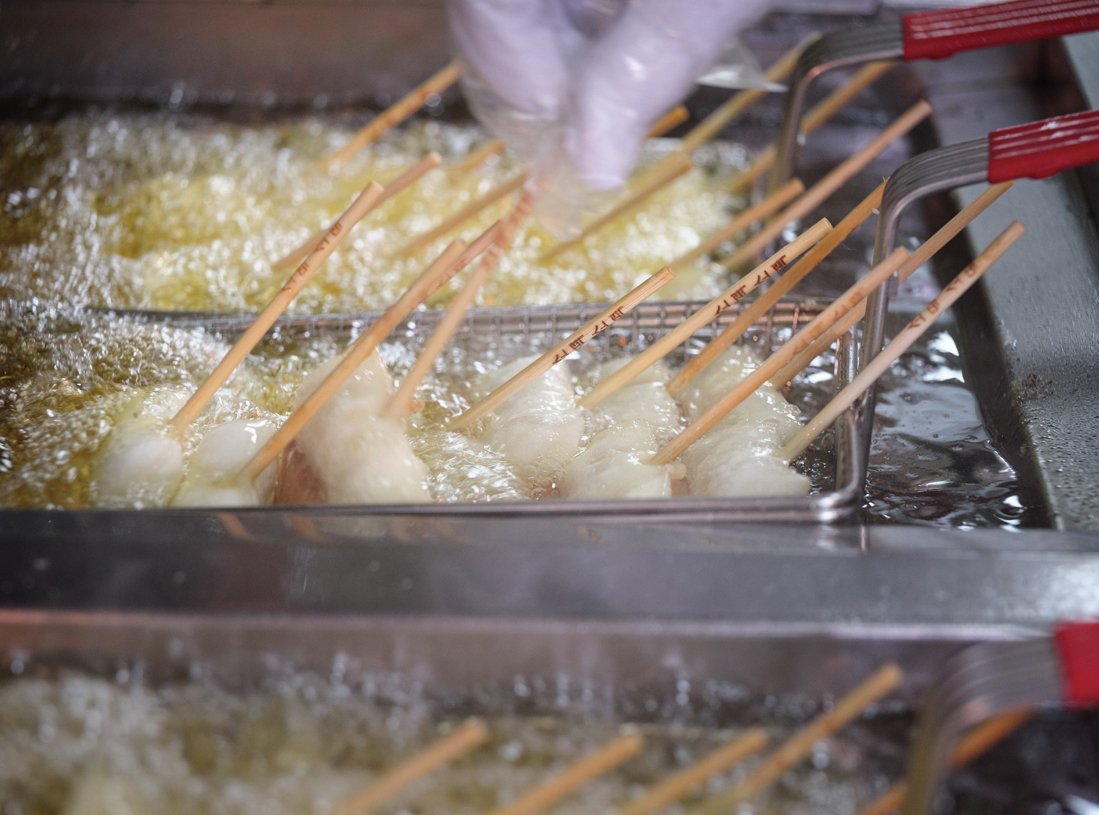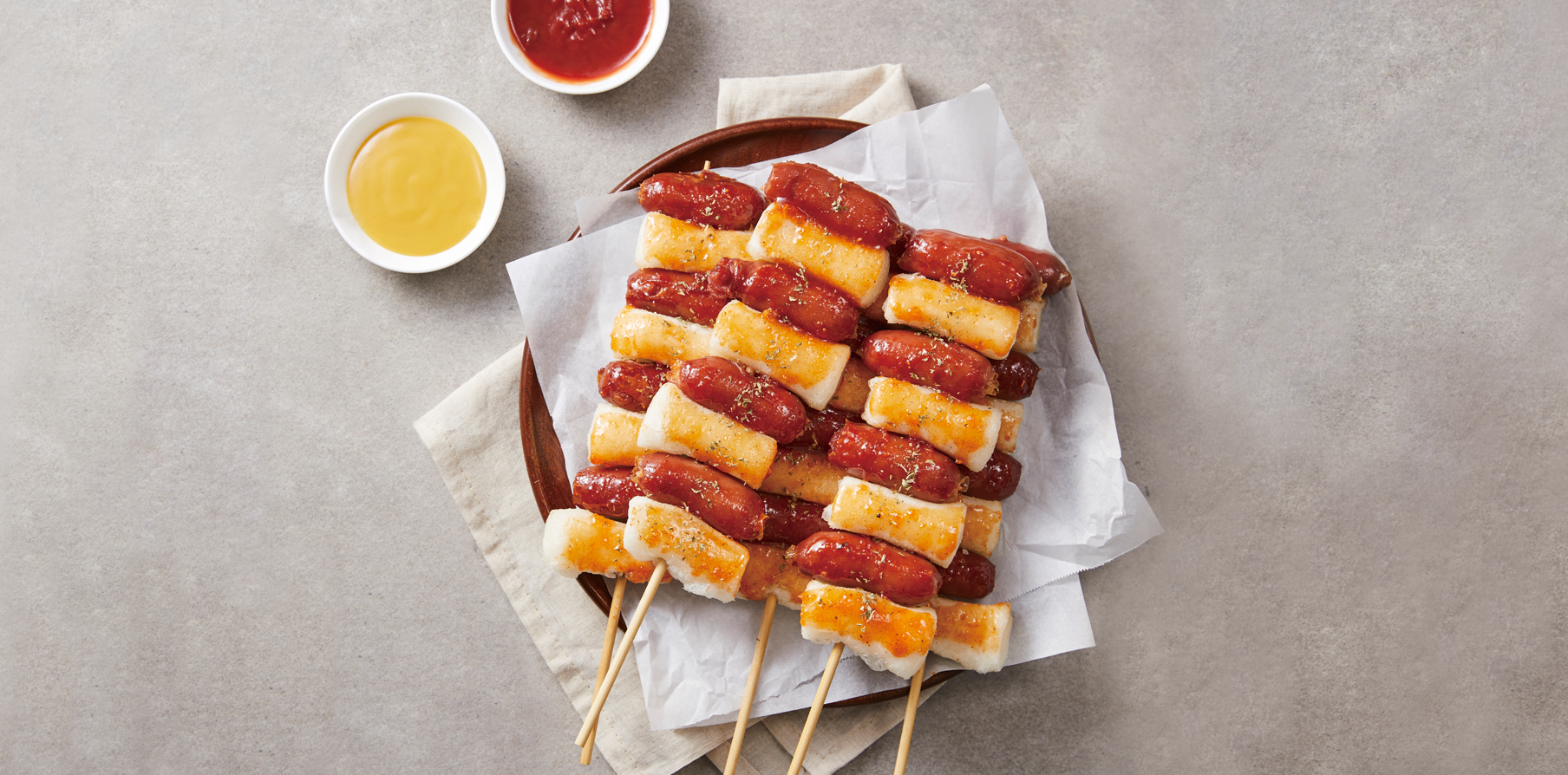Flavor
Rest or Restaurant Stop?
So-tteok so-tteok
Many hit the road in summer in the pursuit of respite and adventure across the country. Yet instead of being stopovers on long drives, highway rest stops are packed with trendy snacks and delicacies, one of the more popular ones being a sausage and tteok (rice cake) on a skewer, or so-tteok so-tteok.
Written by
• Kim Samuel
Photographed by• Studio Kenn
Just a cursory look at a map of Korea is needed to fathom the mighty presence of highways. Stemming from the main Gyeongbu Expressway that diagonally connects Seoul and Busan, coastal and inland regions alike are densely interconnected. The nation’s first freeway was the Gyeongin Expressway (spanning 22 km), opened in 1968 to link Seoul and Incheon, and a crucial part of Korean industrialization, the Gyeongbu Expressway (428 km), was completed in 1970.
Korea has 160 rest stops (excluding makeshift ones and those reserved for cargo transport staff) across the country. In 1971, Chupungnyeong Service Area was the first of its kind to open its doors in the nation, but back then, simple snacks like noodles and dried squid were the only things offered. During holidays, homebound passengers often ate home-packed meals or even those cooked outdoors as if camping, but this has drastically changed over the last 50 years.
From the 2000s, the construction of more expressway lanes saw rest stops evolve in tandem. Of the nation’s first two rest stops, Chupungnyeong and Geumgang, the latter was refurbished in 2003 into a nature-friendly space. As such, specialized or conceptually distinguished rest stops emerged, including the Siheung Ganeul rest stop, which was built in 2017 as the nation’s first aerial rest stop. Furthermore, certain stops often offer a wide variety of food offerings, and some get so famous via social media that they become the destinations rather than mere stopovers. There are even contests for best food served by a restaurant at a rest stop.

At the Busan-facing Anseong Service Area, so-tteok so-tteok skewers are deep fried in oil.
Rediscovering the Familiar
In a 2018 survey by Cosmojin, a Korean travel agency for foreign tourists, 55% chose highway rest stops as “the most intriguing type of Korean facility,” giving responses like “surprised at what spacious areas there were on highways,” “delight over the assorted food options,” and the “unforgettable taste of tteokbokki (spicy rice cake), ggochi (skewers) and hodoogwaja (walnut pastries).”
From sweet potato sticks to stone-plated cooked squid, DeliManjoo (custard pastries), udon, potato chunks, sausages, dried filefish fillet, hobangnyeot (Korean pumpkin malt candy), tteokbokki and ggochi, rest stops on highways are teeming with Korean munchies.
To commemorate its 50th anniversary, the Korea Expressway Corp. conducted a survey to form a bucket list for those going to rest stops. Sogogigukbap (beef and rice soup) served by Busan-facing the Seoul Underground Rendezvous Service Area ranked first, followed by deodeok (bellflower roots) beef steak served by the Gangneungfacing Hoengseong Service Area and so-tteok so-tteok served by the Busan-facing Anseong Service Area. The sausage-rice cake dish so-tteok so-tteok topped all snacks in popularity. The plain-looking wood skewer is grilled or fried, and though around for a long time, it enjoyed instant fame after comedian Lee Young-ja raved about it on TV.
At the Anseong rest stop, dozens of so-tteok so-tteok are fitted into displays. Gochujang (chili) sauce is popularly applied as glaze, while others are content with the classic dressing of ketchup and mustard. Even kids who want to pick at the sausage bits only end up consuming the softly textured tteok. This humble snack, which virtually had no acknowledged presence until 2018, is served at numerous rest stops, convenience stores and even PC bang (cafes). Discovering something new from the familiar is perhaps the greatest reward in traveling.

Foodies can dress a skewer with a variety of sauces.
Simple Trips

A child salivates over his skewer before taking a bite.
So-tteok so-tteok is simplistic in every way, using common ingredients and not-so-hard processes. Though garaetteok (cylindershaped rice cakes) are ideal, any tteok, whether made of rice or wheat or even those sold to make tteokbokki at corner shops, will do. Though similarly sized sausages and tteok are ideal, the more compact the meat concentration results in better outcomes.
If the tteok is frozen or hardened, submerge it in water before thawing it in boiling water for a minute or two to maximize the soft and chewy texture. Then alternate the wooden skewer with sausage and tteok. Grill its well-oiled surface with a frying pan or dip in boiling oil to fry. Season with the desired sauces, with ketchup the choice for many.
One suggestion is to chew the sausage and tteok together, not separately, as combining their flavors yields a new type of chewy taste. This snack and plenty of others will keep hungry travelers scouring rest stops on Korean expressways in search of addictive food.



















